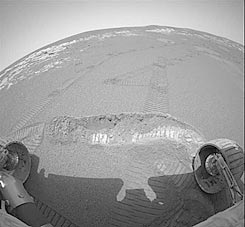Spirit and Opportunity found high concentrations of sulfur salt that form in the presence of water that was probably there before

Mars may stink to the heavens. Recent discoveries from the two space vehicles exploring Mars - Spirit and Opportunity - have transmitted data about the volcanic landscape, full of evidence of the presence of water in the past.
For example, in the Meridian plane, where the Opportunity operates, the robotic field geologist found high concentrations of sulfur. The chemical structure of the compounds in which the sulfur is found also include magnesium, iron or other sulfate salts. Using the scientific equipment, the robot was able to identify a mineral containing oxidized sulfur and iron called jarosite.
On Earth, rocks with such a high concentration of sulfuric salt were formed either in the presence of water or after their formation were altered due to prolonged exposure to water. Gerosite may indicate a point in time when the rock was either in an acidic lake or around acidic hot springs. Sulfur, acids, magnesium, iron - all these together stink.
"If there is sulfur and an oxidizing environment, you will get sulfates, and then, if you are also in an environment that promotes acidity such as for example acidic groundwater, you will have sulfuric acid. From all of these come hydrogen sulfides as a byproduct of reactions to the point that the matter begins to stink," says Jim Garvin, the lead scientist on behalf of NASA in the study of the Moon and Mars in Washington.
Garvin and his team studied volcanic regions on Earth. "I know it may stink, but it's in the eyes of the beholder." While the aroma on Mars may not bother the indifferent robots, knowing more about the environment may help future manned missions.
One of these compounds, hydrogen sulfide (H2S) is a common gas on Earth. Excavation in rocks where this gas is trapped can cause problems. In addition to the unpleasant smell, it also causes headaches and is also explosive and toxic. There is no doubt that manned missions that will reach Mars will be equipped to work outside their habitable zone, but it will be necessary to take precautionary measures in this regard as well.
The astronauts on the moon brought mud in their shoes when they re-entered the landing compartment. After they took off their helmets, the smell was like that of a wet rag after putting out fires, and even the smell of gunpowder from a gun that you fired. If Mars is to be home to 21st century astronauts, a lot more data about the planet will be needed before humans set foot, and nose, on it.
